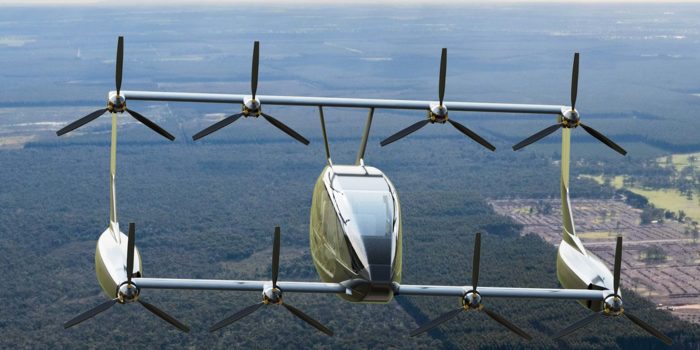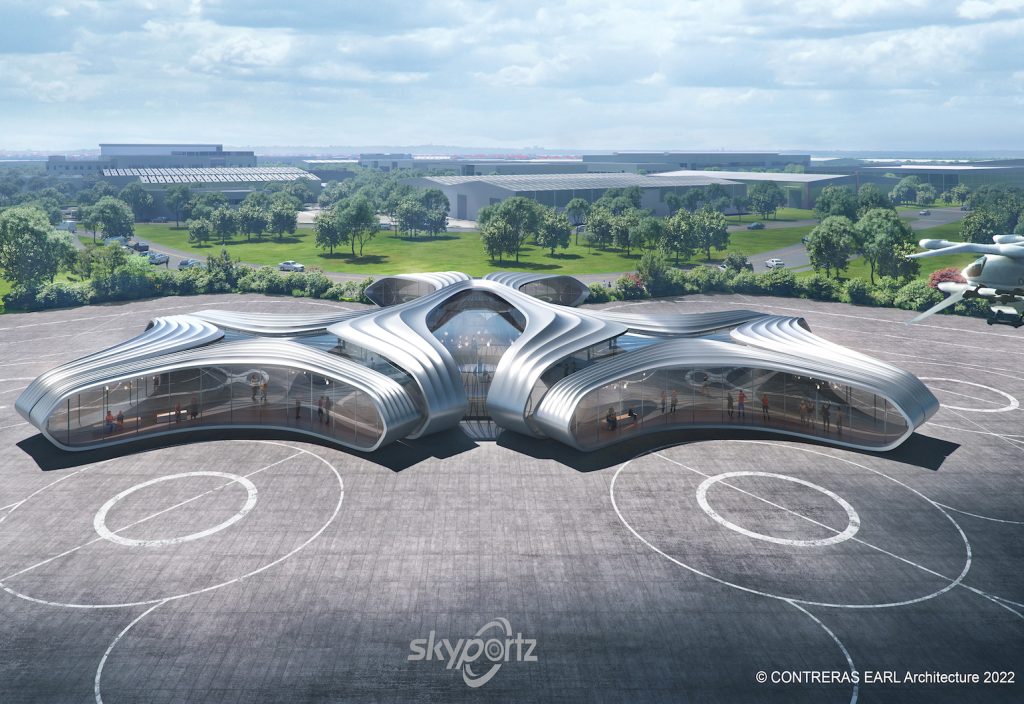While it might seem to be a long-held distant dream, air taxis are close to becoming a feature of our lives. At the Avalon Australian International Airshow 2023, a number of Advanced Air Mobility (AAM) vehicles and infrastructure proposals were on display.
AAM is used to describe vehicles – or, more correctly, systems – that have otherwise been confusingly labelled as drones, eVTOLs, UAVs, powered-lift aircraft, UAMs, air taxis, multi-rotor helicopters and flying cars. AAM systems are typically passenger-carrying battery-electric aircraft and their associated software and physical infrastructure.

Clem Newton-Brown is CEO of Skyportz, a Melbourne-based company focused on developing a network of “vertiports” around Australia. The Airshow Conference Centre hosted a presentation by Skyportz on Air Taxis. “This is going to be a multi-trillion dollar industry”, says Newton-Brown.
Most of the vehicle design and development is happening in Europe and the USA, but Australia is fighting to get on the map in the AAM space. Happily, Australia is making inroads in setting up cooperative partnerships between government, property developers, local innovators and international developers and manufacturers.
Although no AAM vehicles are operating commercially yet, there are a multitude of designs flying around the world. Bankstown-based AMSL Aero accomplished the maiden flight (albeit tethered and unmanned) of its Vertiia aircraft in February 2023. Overseas, AAM systems include Joby (a tilt-rotor design), Beta (with lift and push rotors), Archer (another tilt-rotor), and Volocopter (a multirotor). In August 2022, United Airlines ordered 100 Archers for routes from airports to city centres from 2025. German-designed Volocopters are expected to be operating tourist flights in Singapore, and will launch an air taxi service in Paris in 2024.

Newton-Brown believes that the first AAM aircraft will use helicopter infrastructure, and assume some of the helicopter’s tourist and shuttle business. However, Skyportz is identifying sites for vertiports that include charging infrastructure. A recent partnership with Pelligra property developers has identified around 1400 potential vertiport sites around Australia; in caravan parks, in carparks, at shopping centres, at sports stadiums, in industrial parks, at theme parks.
An industry finally taking off
The Federal Government, along with state governments, CASA and Air Services, have been making progress in providing a regulatory and political environment in which AAM ecosystems can develop. The Avalon Air Show exhibition pavilions, open from 28 February to 5 March, were awash with AAM offerings, and it has been suggested that it might be time for a specialised AAM industry display event.
AAM systems operate in an entire ecosystem which includes the booking software platform, air traffic management, a network of vertiports, a viable business model and, of course, safety systems and processes. The engineering opportunities are obvious.
Innovation needs community licence
Damian Ogden, Engineers Australia Group Executive, Policy and Public Affairs (A/g) is excited about the possibilities that technology can bring to air mobility. “Instead of calling up an Uber, I can head to a nearby ‘sky port’ and board an automated vehicle that takes off vertically and flies me to my destination.”
There are, of course, many hurdles ahead. Ogden points out that “care needs to be taken to ensure safety is not compromised, or liveability and amenity for those living close by does not suffer.” This “community licence” is made more difficult because of the poor reputation of hobby and commercial drones. If AAMs initially take over some of the work of helicopters, goodwill may be grown as quieter AAMs generate only around 50 to 60 db on take-off.
As the industry matures and large-scale manufacture reduces unit costs, and with much lower maintenance, fuel, and back-of-house requirements, AAMs will surely be transformative. Ogden says “the improvements to accessibility and productivity this could allow for are huge.”
Perhaps controversially, most AAMs are being designed to be autonomous, but will be initially operated by a pilot to gauge customer sentiment. Wisk, a joint venture between Boeing and Kitty Hawk Corporation, is bypassing the piloted stage from the start, and is going straight to autonomous with its four-seat air taxi. Ride-sharing is one obvious business model, and when it is seen as being safe as getting on a plane or a helicopter, the option of “going to a winery for my partner’s birthday”, as Newton-Brown puts it, will be within reach of many people.
